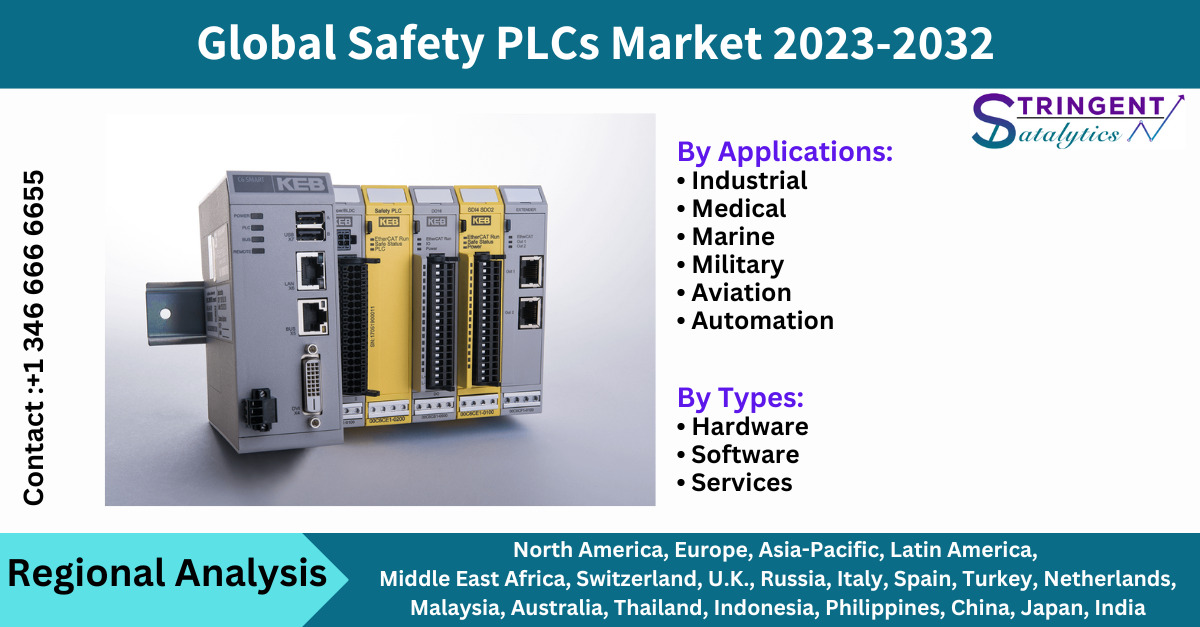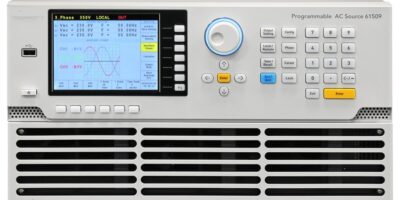Overview of the Safety PLCs Market:
Safety PLCs are a critical component in industrial automation and control systems, designed to ensure the safety and reliability of industrial processes and machinery. These specialized PLCs are equipped with safety functions and features to prevent accidents and protect both workers and equipment in industrial settings.
Key aspects of the Safety PLCs market include:
- Market Growth: The Safety PLCs market has been experiencing steady growth due to increasing industrial automation, stringent safety regulations, and the need for risk mitigation in manufacturing environments.
- Applications: Safety PLCs are widely used in industries such as manufacturing, automotive, chemical processing, oil and gas, pharmaceuticals, and more. They are essential in scenarios where processes involve high risks to human safety.
- Safety Standards: Compliance with safety standards and regulations (e.g., IEC 61508, ISO 13849) is a driving factor in the adoption of Safety PLCs. Companies are increasingly focused on achieving higher levels of safety integrity.
- Features: Safety PLCs offer features like redundancy, self-diagnosis, fail-safe operation, and SIL (Safety Integrity Level) certification, ensuring reliable safety control.
- Integration: Integration with other automation systems, such as standard PLCs and Human-Machine Interfaces (HMIs), is crucial for seamless operation and monitoring.
- Market Players: Prominent players in the Safety PLCs market include Siemens, Rockwell Automation, ABB, Schneider Electric, Honeywell, and others. Competition in the market is robust, driving innovation and product development.
- Emerging Technologies: The market is witnessing advancements in technologies like functional safety software, IIoT (Industrial Internet of Things) integration, and cloud-based safety solutions.
- Global Reach: The market for Safety PLCs is global, with demand from various regions, including North America, Europe, Asia-Pacific, and Latin America.
- Challenges: Challenges faced by the industry include addressing the complexity of safety systems, ensuring interoperability with existing equipment, and managing the cost of implementing safety measures.
- Future Trends: Anticipated future trends include the adoption of machine learning and AI for predictive maintenance and safety analytics, as well as the continued development of safety-certified industrial robots.
Key Growth Developments:
- Rising Industrial Automation: The increasing trend toward industrial automation across various sectors, including manufacturing, automotive, chemicals, and more, has driven the demand for Safety PLCs. Industries are automating processes to improve efficiency, reduce human error, and enhance safety.
- Stringent Safety Regulations: The implementation of strict safety regulations and standards by governments and industry bodies has made Safety PLCs essential in compliance. For example, the IEC 61508 and ISO 13849 standards require the use of safety-related control systems, including Safety PLCs, to achieve specific safety integrity levels (SILs).
- Integration with IoT: Safety PLCs are increasingly integrated with Industrial Internet of Things (IIoT) technology, enabling remote monitoring, predictive maintenance, and real-time data analysis. This integration enhances overall system safety and efficiency.
- Advancements in Functional Safety: Ongoing advancements in functional safety technology have led to the development of Safety PLCs with more advanced safety functions, self-diagnosis capabilities, and improved fail-safe mechanisms.
- Global Market Expansion: The Safety PLCs market has expanded globally, with manufacturers and end-users recognizing the importance of safety in industrial operations. This growth is particularly significant in emerging markets.
Advantages of Safety PLCs:
- Safety Functionality: Safety PLCs are specifically designed to handle safety-critical tasks, providing functions like emergency stop, light curtains, and safety interlocks to prevent accidents.
- Reliability: Safety PLCs are highly reliable due to features such as redundancy and self-diagnosis, ensuring safe operation even in the event of component failures.
- Compliance: Safety PLCs help industries meet safety standards and regulatory requirements, reducing the risk of accidents, injuries, and legal liabilities.
- Integration: They can be seamlessly integrated with standard PLCs, HMIs, and other automation components, allowing for comprehensive control and monitoring of industrial processes.
- Scalability: Safety PLCs can be scaled to accommodate changes in the production process or system expansion, making them adaptable to evolving needs.
- Diagnostic Capabilities: Safety PLCs provide detailed diagnostic information, helping maintenance teams quickly identify and address issues.
Benefits of Safety PLCs:
- Worker Safety: The primary benefit of Safety PLCs is improved worker safety. They prevent accidents and protect employees from harm by controlling hazardous machinery and processes.
- Process Reliability: Safety PLCs enhance process reliability, reducing downtime and production interruptions by preventing unsafe conditions.
- Cost Savings: While the initial investment in Safety PLCs may be significant, they can lead to cost savings in the long run by minimizing accidents, equipment damage, and legal penalties.
- Compliance Assurance: Companies using Safety PLCs can demonstrate compliance with safety standards, which is essential for maintaining a positive reputation and ensuring legal compliance.
- Competitive Advantage: Businesses that prioritize safety through Safety PLCs may gain a competitive advantage by attracting safety-conscious customers and partners.
- Peace of Mind: Knowing that safety is being managed effectively with Safety PLCs provides peace of mind to both management and employees.
Receive the FREE Sample Report of Safety PLCs Market Research Insights @ https://stringentdatalytics.com/sample-request/safety-plcs-market/2163/
Market Segmentations:
Global Safety PLCs Market: By Company
• ABB
• Siemens
• Pilz Automation Safety
• Rockwell Automation
• Mitsubishi
• Koyo
• Schneider (Modicon)
• Panasonic
• Omron
• Idec
• B&R Industrial
• Keyence
• GE Fanuc
• Beckhoff
• Toshiba
• Fuji
Global Safety PLCs Market: By Type
• Hardware
• Software
• Services
Global Safety PLCs Market: By Application
• Industrial
• Medical
• Marine
• Military
• Aviation
• Automation
Regional Analysis of Global Safety PLCs Market
All the regional segmentation has been studied based on recent and future trends, and the market is forecasted throughout the prediction period. The countries covered in the regional analysis of the Global Safety PLCs market report are U.S., Canada, and Mexico in North America, Germany, France, U.K., Russia, Italy, Spain, Turkey, Netherlands, Switzerland, Belgium, and Rest of Europe in Europe, Singapore, Malaysia, Australia, Thailand, Indonesia, Philippines, China, Japan, India, South Korea, Rest of Asia-Pacific (APAC) in the Asia-Pacific (APAC), Saudi Arabia, U.A.E, South Africa, Egypt, Israel, Rest of Middle East and Africa (MEA) as a part of Middle East and Africa (MEA), and Argentina, Brazil, and Rest of South America as part of South America.
Click to Purchase Safety PLCs Market Research Report @ https://stringentdatalytics.com/purchase/safety-plcs-market/2163/
These questions can help you gather data and insights to create a comprehensive report on the market.
- Market Overview:
- What is the current size and growth rate of the global Safety PLCs market?
- What are the key drivers and challenges influencing market growth?
- What are the major trends shaping the Safety PLCs market?
- Market Segmentation:
- What are the primary product types and their market shares?
- How is the Safety PLCs market segmented by end-user industry (e.g., manufacturing, oil and gas, automotive)?
- Are there regional variations in Safety PLCs adoption?
- Competitive Landscape:
- Who are the major players in the Safety PLCs market?
- What is their market share and competitive positioning?
- Are there any emerging players or startups disrupting the market?
- Market Dynamics:
- What are the factors driving the adoption of Safety PLCs in various industries?
- What regulatory and safety standards impact the Safety PLCs market?
- What are the key challenges faced by users and manufacturers of Safety PLCs?
- Market Opportunities:
- Are there untapped market opportunities in specific regions or industries?
- What are the growth prospects for Safety PLCs in emerging markets?
- Are there new applications or technologies that could drive market expansion?
- Technology Trends:
- What are the latest advancements in Safety PLC technology?
- How is the integration of Safety PLCs with other automation systems evolving?
- Are cybersecurity concerns affecting the adoption of Safety PLCs?
Customization of the Report:
This report can be customized to meet the client’s requirements. Please connect with our sales team (sales@stringentdatalytics.com), who will ensure that you get a report that suits your needs. You can also get in touch with our executives on +1 346 666 6655 to share your research requirements.
Enquiry Before Buying @ https://stringentdatalytics.com/inquiry/safety-plcs-market/2163/
Reseason To Purchase Safety PLCs Market Report :
Purchasing a research report provides valuable insights and information on a specific topic or industry, which can be beneficial for informed decision-making, market analysis, competitive intelligence, and staying up-to-date with trends and data. It saves time and effort by consolidating comprehensive research findings into one document, offering a structured and reliable source of information.
Our More Reports:
About Stringent Datalytics
Stringent Datalytics offers both custom and syndicated market research reports. Custom market research reports are tailored to a specific client’s needs and requirements. These reports provide unique insights into a particular industry or market segment and can help businesses make informed decisions about their strategies and operations.
Syndicated market research reports, on the other hand, are pre-existing reports that are available for purchase by multiple clients. These reports are often produced on a regular basis, such as annually or quarterly, and cover a broad range of industries and market segments. Syndicated reports provide clients with insights into industry trends, market sizes, and competitive landscapes. By offering both custom and syndicated reports, Stringent Datalytics can provide clients with a range of market research solutions that can be customized to their specific needs.
Reach US
Stringent Datalytics
+1 346 666 6655
Social Channels:




Leave a Reply